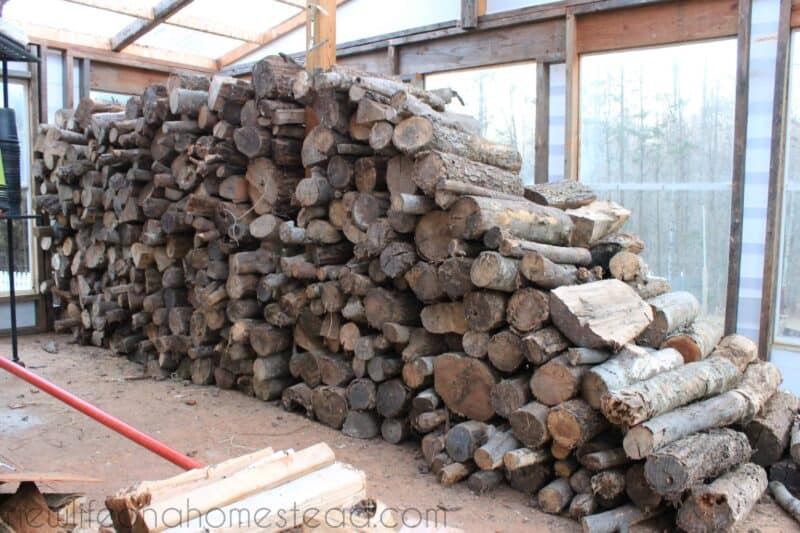Though most folks in the US these days rely on gas or electric heat, wood is still a crucially important fuel source for supplementary heat and, for some of us homesteaders, primary heating in the home.

But whether you’re depending on wood to keep you alive, or you just like the cheery ambiance of a fireplace or fire pit in the cold season, you’ve got to have a good supply of wood to stoke it.
In places that have long, harsh winters, you’ll typically see firewood advertised by the bush cord. Just how much does a bush cord cost, anyway?
A bush cord of wood will usually cost between $150 to $500, maybe even a little more depending on the specifics of the wood and the local market.
That’s a lot of money, for sure, but it’s a whole lot of firewood! But these days everything costs more, including good wood.
Nonetheless, buying in bulk, now as ever, tends to save you money in the long run, but there’s more you’ll need to know about bush cords before you commit to a purchase. Keep reading and we’ll get right into it…
Prices Vary From Market to Market
As you might have guessed already, the price of firewood fluctuates from place to place. It’s kind of like a commodity, in that way. Basically, the warmer your region and the milder the weather, the less wood will cost, all things being equal.
And the opposite is true, too: if you live in a place with long, brutal winters, firewood is more valuable and will cost more.
There are other factors you can’t control that will likewise affect what you pay for it. Shortages affect supply and demand like every other thing on the market, and outbreaks of diseases, pests, or any problems with harvesting trees can likewise result in material shortages or supply-side delays that could see firewood going for a premium.
If you depend on wood, even in a supplemental fashion, it pays to keep an ear to the tracks so you can understand what might affect the firewood supply.
Seasoned Wood Costs More
If you regularly burn wood for any purpose whatsoever, you already know that seasoning your firewood is critically important.
For those of you who are unfamiliar, seasoning refers to the process of thoroughly drying out the wood so it will ignite more readily, burn cleaner, and produce more heat.
Seasoning is another factor that affects the price of a bush cord, with green, moist, and heavy wood selling for cheaper while well-seasoned wood that is ready to go straight into the fire will sell for more.
Some enterprising sellers might chop down unwanted or nuisance trees, process them into the correct size for a bush cord, and then advertise it accordingly that very same day, hoping that someone will come and haul it away and pay them for the privilege.
Expect to Pay More in the Winter
You might think it’s cruel or a nasty side effect of capitalism, but when the weather is cold and winter has truly set in, the prices of firewood go up. It’s just the way it is!
It’s the same reason that people can sell bottles of water for $5 at the beach on a hot summer day. In the grocery store, that same bottle might only be a dollar, but you aren’t thirsty when you’re grocery shopping!
If you’re willing to stock up ahead of time (and let’s face it, you really should be) you can usually save money on the same type and grade of wood by buying it in the spring or summer when blazing fires are the last things on most people’s minds.
Hardwood Firewood Usually Costs More
Know what kind of firewood you are getting. I mean what species of wood. I don’t like paying more for softwood when it doesn’t have as much heat value as hardwoods. Hardwoods like cherry, ash, and oak burn hotter, burn cleaner, and usually burn longer compared to softwoods like pine.
In some places, firewood is firewood, and you won’t see much fluctuation in price, but smart sellers, and hopefully smart buyers, know the difference and will charge, or refuse to pay, accordingly.
On that note, don’t get upset if a seller is charging a premium for good, seasoned hardwood compared to softwood: it’s almost always worth it!
Always Measure Your Bush Cord So You Don’t Pay Too Much
The last tip I will give you is this: trust but verify. When a seller is advertising a bush cord of firewood, you shouldn’t take their word for it unless you’ve done business with them before and trust them implicitly.
A bush cord refers to a volume of firewood: 128 cubic feet, to be exact. If stacked tightly and properly, this much firewood will form a stack that is 8 feet long, 4 feet tall, and 4 feet deep, with minimal spacing between the individual pieces.
Bust out your tape measure and make sure. A good seller won’t mind, and you’ll know exactly what you are getting. Unscrupulous sellers tend to stack the wood with little care or deliberate gaps and spaces to maximize profits while screwing the customer- that’s you!
Tom has lived and worked on farms and homesteads from the Carolinas to Kentucky and beyond. He is passionate about helping people prepare for tough times by embracing lifestyles of self-sufficiency.
